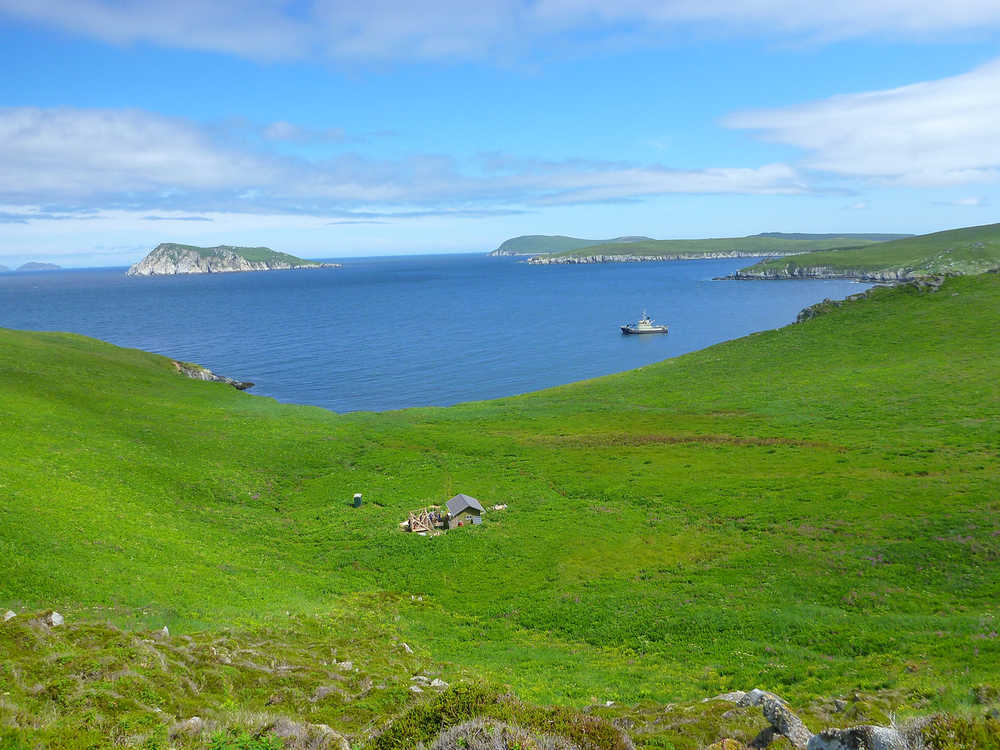While understanding the ecological system of the place where you work and inhabit is an invaluable, lengthy process, the chance to occasionally visit new places for collaborative research and data collection is an exciting opportunity for a vegetation ecologist. My recent trip to a number of Aleutian Islands within the Alaska Maritime National Wildlife Refuge, on board their research vessel the R/V Tiglax, was reminiscent of the early adventurous days of botanical exploration in far-flung places of the earth.
Scientists from the refuge and other agencies on board included wildlife, bird, range, and vegetation experts. The diverse group illustrated the merits of collaborative work, inspiring discussion and resources and offering changes to learn from each other. The pace of the journey allows time to process specimens and data, plan the next island visit, and discuss what you saw — as well as time to read a book, catch a movie, and rest a bit — as long as the waves aren’t too big.
On the two week voyage, we visited several different islands. The trip had multiple purposes, but I was there primarily to look for invasive plant species and assist with vegetation work. Islands are fascinating habitats for vegetation ecologists in that each island is a self-contained laboratory, challenging us to understand why each island has a bit different plant composition — luck? History? Deliberate planting? Incidental introductions?
We first stopped at East Amatuli Island, one of the Barren Islands, to drop off a bird survey field crew, with all their supplies for two months. Long field stints in isolated, magical locations are the norm in the summer around this refuge. I had my first immersion in the typical treeless Aleutian island vegetation.
Our next stop was Chirikof Island, where cattle have been present since the late 1890s. We first went ashore in the southwestern part of the island, encountering low beach bluffs and bleached piles of gigantic spruce driftwood, interspersed with colorful buoys, large tangles of boat line, and bits of plastic.
The healthy looking cattle, numbering over 700, run unfenced on the beaches and hills.
The first day passed without incident, although several large sentinel bulls made us nervous. The second day, on the north side of the island, we found ourselves in the center of a cow stampede in a meadow with nothing but an old fence post for shelter. Luckily the cows turned, the bulls ran off, and we didn’t have to explain the ignominy of demise by cow trampling after many years of working in bear country in remote Alaska.
Prior vegetation surveys had recorded a number of non-native plants, and I found some species mixed in with native vegetation throughout the island, including mouseear chickweed and Kentucky bluegrass. More obvious aspects of cattle presence was massive erosion of beach ryegrass (their preferred forage) habitat, and shifts from typical Aleutian diverse plant communities to new assemblages with high proportions of lupine (a non-palatable species) and deschampsia grass (another non-preferred plant that increases with grazing).
Our next stop was to the lush, dramatic wedge of Chowiot Island, with its imposing seabird-filled cliffs. Shed construction and camp resupply took some time, and I had the chance to hike around and observe a relatively pristine vegetation environment for contrast — and a rare place where absolutely no non-native plants are found.
The next stop, Simeonoff, was equally fascinating in that cattle had been removed around 1984, giving insight as to what may happen if cattle are managed more closely on cattle-present islands. In the intervening 30 years since removal, beach ryegrass has completely recovered in severe erosion areas and recolonized bare sand spits, and other impacted vegetation types are recovering.
Settlement on the island brought several non-native plant species in, some of which have survived and spread. The old ranchhouse still stands, with a number of species nearby like rhubarb and strawberry originally planted in the garden. Also planted was oxeye daisy, which now invades over five acres of crowberry tundra and old field habitat near the house. Several non-native grasses, likely introduced by hay, were found near the old corrals and fencelines. Another invasion was evident in the spread of Sitka spruce, which had been planted near the house in this treeless landscape — and was now reproducing on its own.
Traveling on to Wosnesenski Island, where the cattle only number around 130, effects on vegetation were more subtle. I still found some non-native plants scattered throughout the island, but erosion was lower.
At first glance, comparing vegetation across islands reveals that most have the same common species, but some have more wetlands, higher elevation, and varying drainage patterns — making each island essentially unique to the variation-seeking eye of the vegetation ecologist. What was evident was that each island’s history crossed with its unique geography had effects on the current vegetation.
Many questions remain — will the spruce continue to thrive and spread on Simeonof? What if a spruce had gotten there by itself — how long would that take naturally? Will changes in cattle management cope with the erosion on Chirikof? Are strawberries the new blueberries in Alaska with a changing climate? Over a Simeonof-grown rhubarb crisp on board the ship that night, we contemplated these questions as we cruised to Dutch Harbor to head back to our regular lives.
Elizabeth Bella is ecologist at the Kenai National Wildlife Refuge. Visit http://www.fws.gov/refuge/kenai/ for more information about the Refuge.

